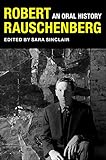Robert Rauschenberg : An Oral History / ed. by Sara Sinclair, Peter Bearman, Mary Marshall Clark.
Material type: TextSeries: The Columbia Oral History SeriesPublisher: New York, NY : Columbia University Press, [2019]Copyright date: ©2019Description: 1 online resource : B&W photographs with color insertContent type:
TextSeries: The Columbia Oral History SeriesPublisher: New York, NY : Columbia University Press, [2019]Copyright date: ©2019Description: 1 online resource : B&W photographs with color insertContent type: - 9780231192767
- 9780231549950
- 709.2 23
- N6537.R27
- online - DeGruyter
- Issued also in print.
| Item type | Current library | Call number | URL | Status | Notes | Barcode | |
|---|---|---|---|---|---|---|---|
 eBook
eBook
|
Biblioteca "Angelicum" Pont. Univ. S.Tommaso d'Aquino Nuvola online | online - DeGruyter (Browse shelf(Opens below)) | Online access | Not for loan (Accesso limitato) | Accesso per gli utenti autorizzati / Access for authorized users | (dgr)9780231549950 |
Browsing Biblioteca "Angelicum" Pont. Univ. S.Tommaso d'Aquino shelves, Shelving location: Nuvola online Close shelf browser (Hides shelf browser)

|

|

|

|

|

|

|
||
| online - DeGruyter Emancipation After Hegel : Achieving a Contradictory Revolution / | online - DeGruyter Concepts and Categories : Foundations for Sociological and Cultural Analysis / | online - DeGruyter Fearing the Worst : How Korea Transformed the Cold War / | online - DeGruyter Robert Rauschenberg : An Oral History / | online - DeGruyter Women Mobilizing Memory / | online - DeGruyter After the Crash : Financial Crises and Regulatory Responses / | online - DeGruyter Why Chimpanzees Can't Learn Language and Only Humans Can / |
Frontmatter -- Contents -- Preface -- Reader's Guide -- Acknowledgments -- Prologue -- 1. Small World -- 2. Collaborations -- 3. 381 Lafayette Street -- 4. Captiva -- 5. Travelogue -- 6. Rauschenberg Overseas Culture Interchange [ROCI] -- 7. Curating and Installations -- 8. An Expanding American Art Market -- 9. No One Wanted It to End -- Network Diagrams -- Narrators -- Notes -- Index
restricted access online access with authorization star
http://purl.org/coar/access_right/c_16ec
Robert Rauschenberg (1925-2008) was a breaker of boundaries and a consummate collaborator. He used silk-screen prints to reflect on American promise and failure, melded sculpture and painting in works called combines, and collaborated with engineers and scientists to challenge our thinking about art. Through collaborations with John Cage, Merce Cunningham, and others, Rauschenberg bridged the music, dance, and visual-art worlds, inventing a new art for the last half of the twentieth century.Robert Rauschenberg is a work of collaborative oral biography that tells the story of one of the twentieth century's great artists through a series of interviews with key figures in his life-family, friends, former lovers, professional associates, studio assistants, and collaborators. The oral historian Sara Sinclair artfully puts the narrators' reminiscences in conversation, with a focus on the relationship between Rauschenberg's intense social life and his art. The book opens with a prologue by Rauschenberg's sister and then shifts to New York City's 1950s and '60s art scene, populated by the luminaries of abstract expressionism. It follows Rauschenberg's eventual move to Florida's Captiva Island and his trips across the globe, illuminating his inner life and its effect on his and others' art.The narrators share their views on Rauschenberg's work, explore the curatorial thinking behind exhibitions of his art, and reflect on the impact of the influx of money into the contemporary art market. Included are artists famous in the own right, such as Laurie Anderson and Brice Marden, as well as art-world insiders and lesser-known figures who were part of Rauschenberg's inner circle. Beyond considering Rauschenberg as an artist, this book reveals him as a man embedded in a series of art worlds over the course of a long and rich life, demonstrating the complex interaction of business and personal, public and private in the creation of great art.
Issued also in print.
Mode of access: Internet via World Wide Web.
In English.
Description based on online resource; title from PDF title page (publisher's Web site, viewed 02. Mrz 2022)


